Abstract
OBJECTIVES. This study sought to examine risk factors associated with human immunodeficiency virus type 1 (HIV-1) seroconversion among active-duty men in the US Army. METHODS. One hundred twenty-eight men with documented HIV-1 seroconversion between 1988 and 1991 were matched to control subjects on demographic variables. Risk factor information was collected for the seroconversion period. RESULTS. Forty-nine case subjects and no control subjects reported same-gender sex; this includes 34 case subjects who also reported sex with women. Seventy case and 118 control subjects reported no risk factors other than heterosexual intercourse. Among heterosexuals, excess risk was noted for men who had sex with women in risk categories defined by the Centers for Disease Control and Prevention (odds ratio = 10.0; 95% confidence interval = 1.3, 78.1). Significant trends of increasing risk for seroconversion were found with increasing numbers of female partners, nonsteady partners, and partners with whom sex occurred on the first day of acquaintance. CONCLUSIONS. In this population, the major risk factor for HIV-1 seroconversion was same-gender sex. Among heterosexuals, sex with anonymous or causal partners increased this risk. Intervention programs should emphasize the risk of indiscriminate partner selection in addition to "safe sex" practices.
Full text
PDF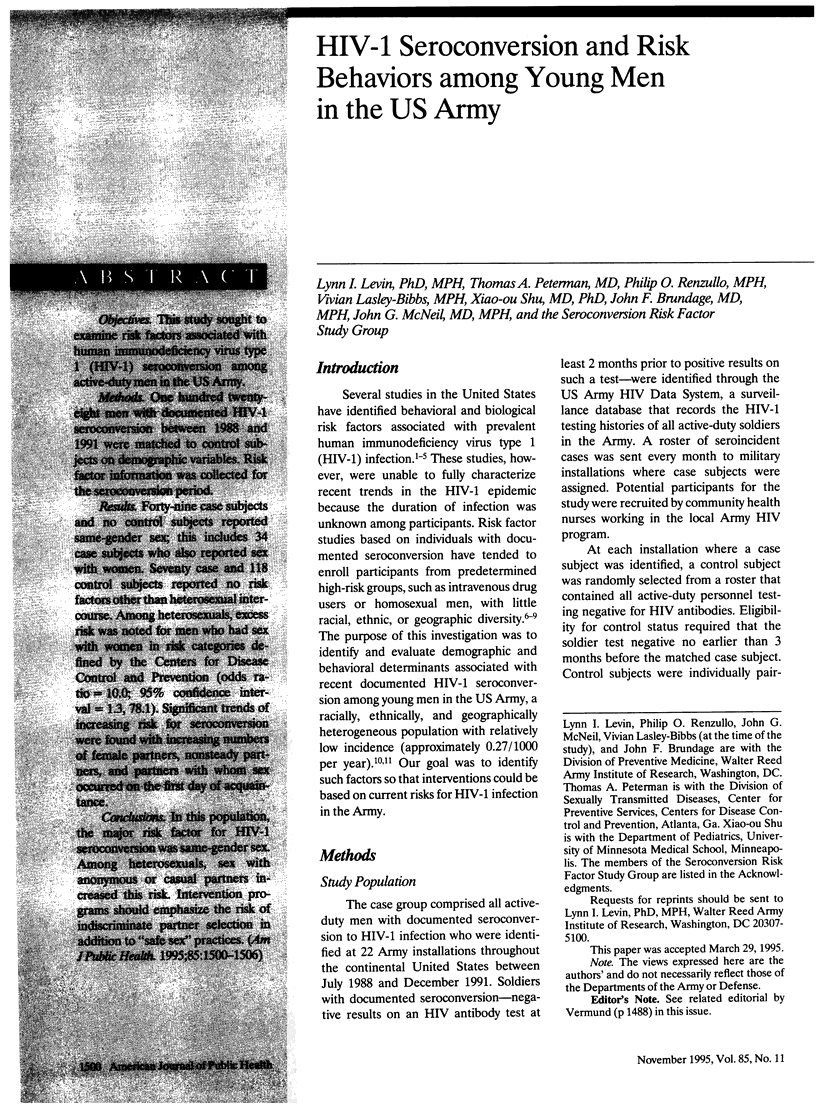
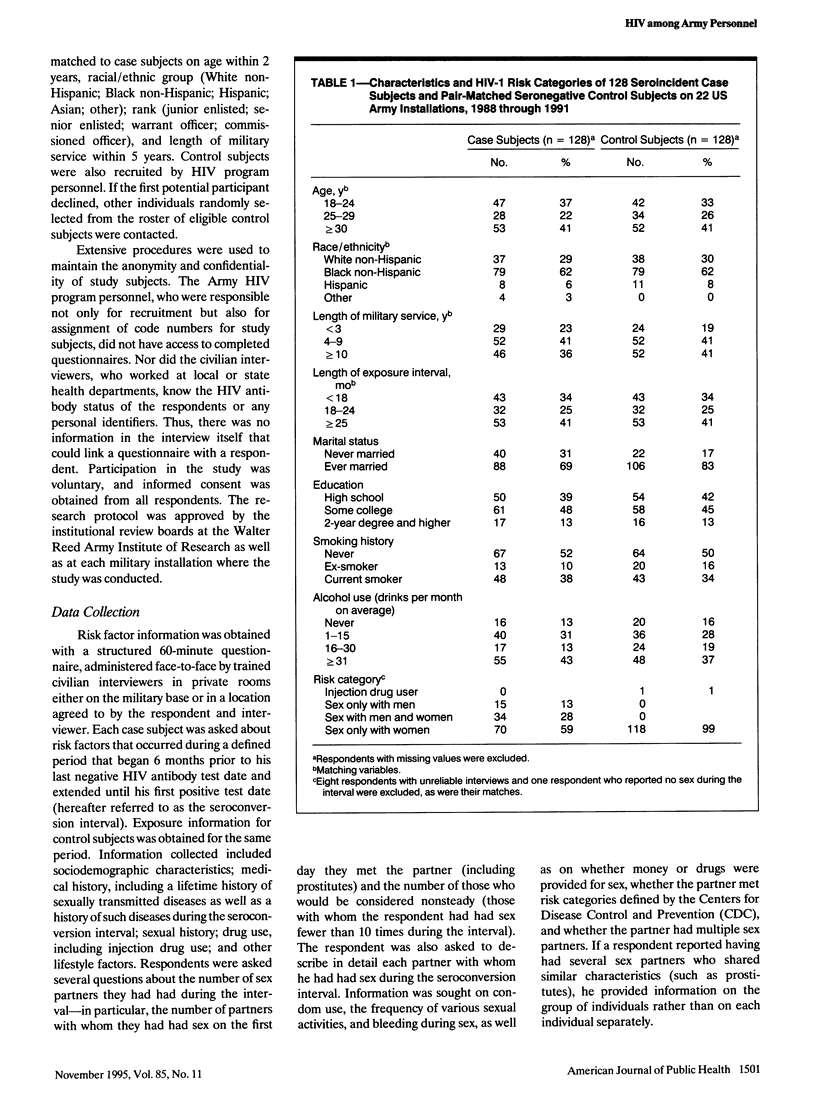
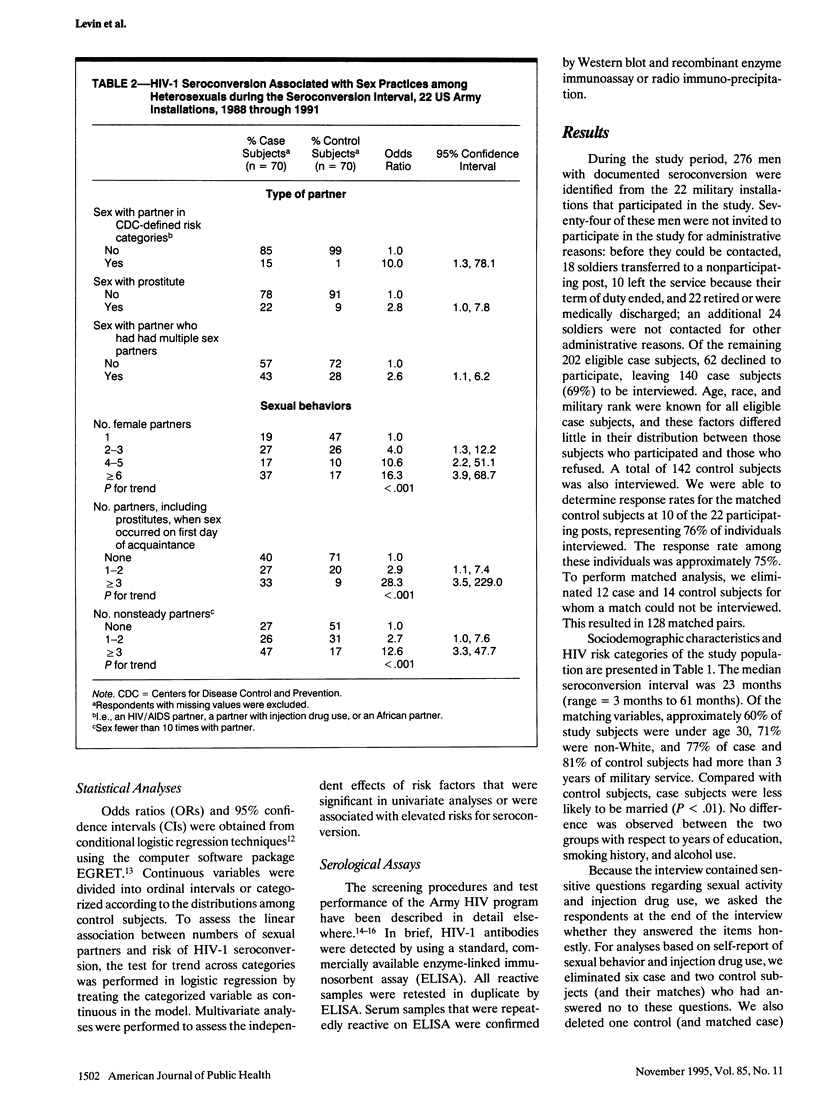
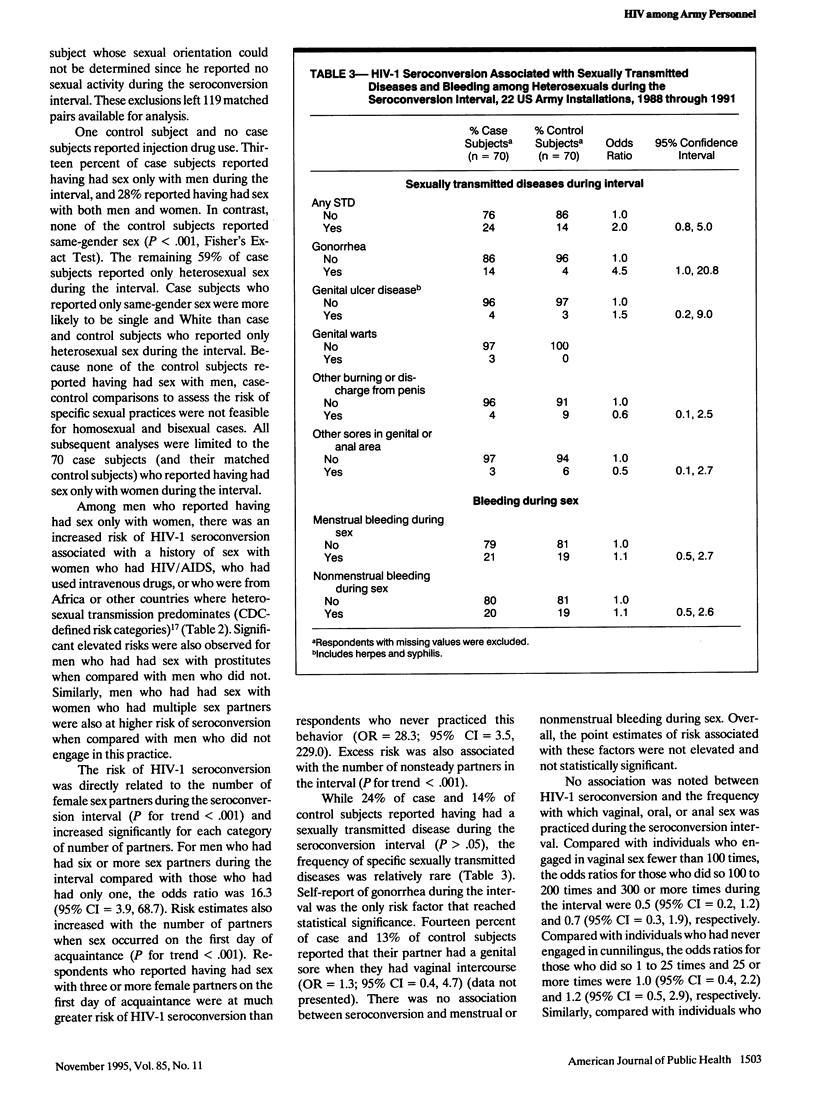
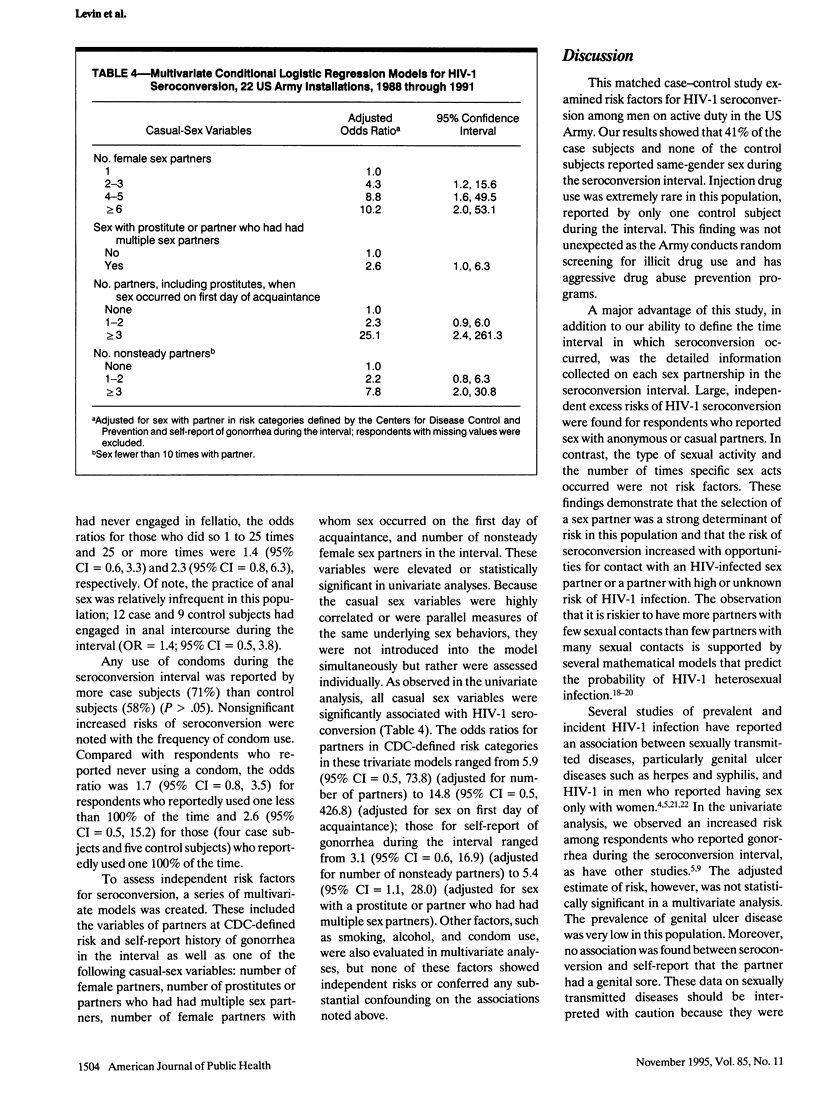
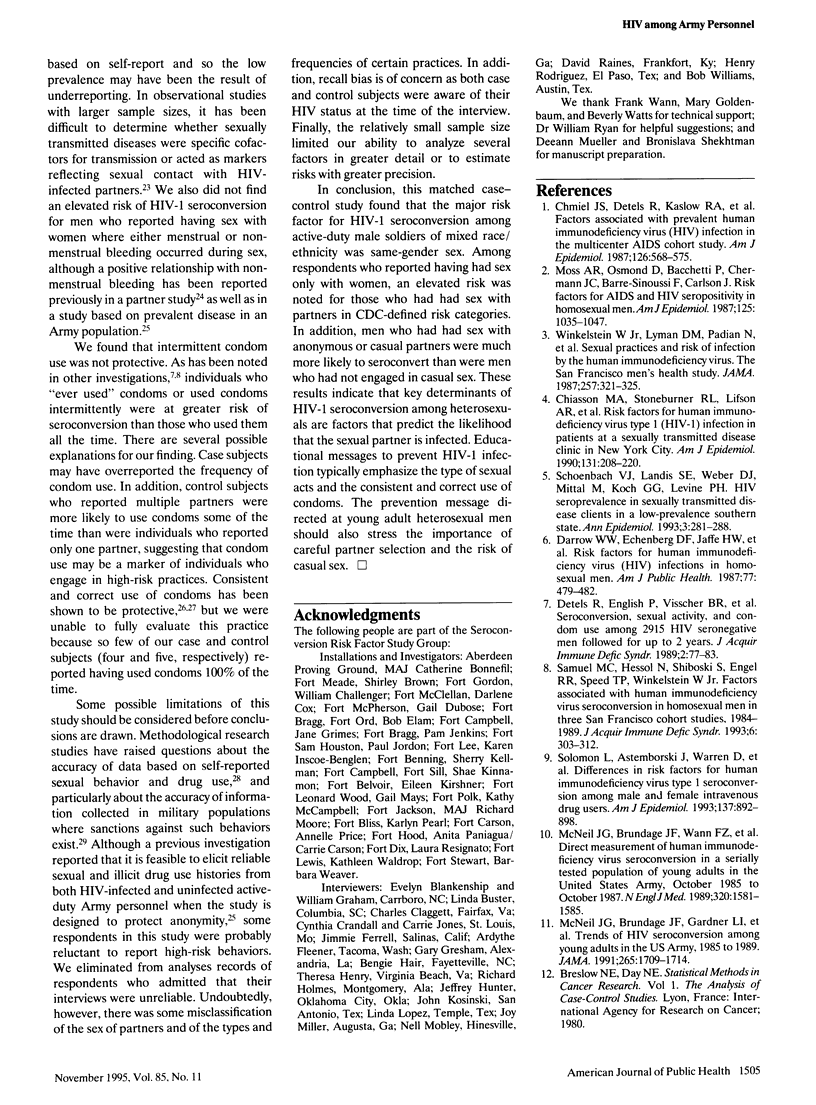
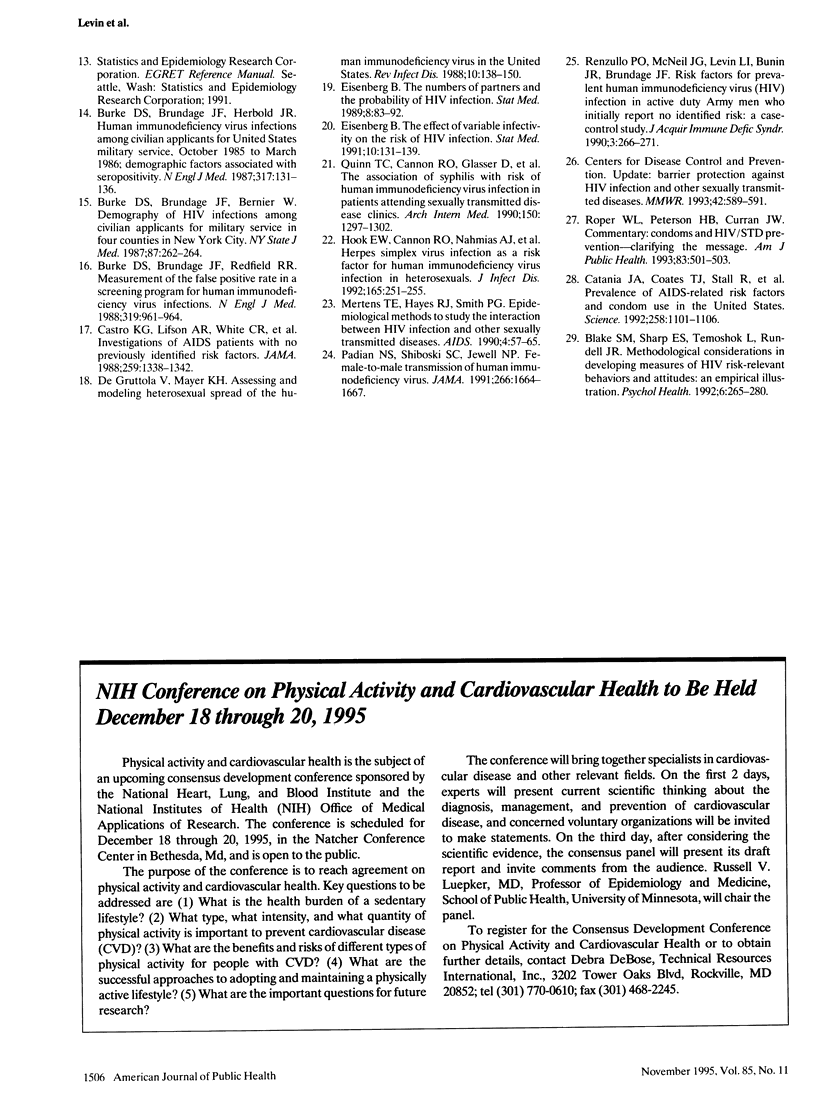
Selected References
These references are in PubMed. This may not be the complete list of references from this article.
- Burke D. S., Brundage J. F., Bernier W., Gardner L. I., Redfield R. R., Gunzenhauser J., Voskovitch J., Herbold J. R. Demography of HIV infections among civilian applicants for military service in four counties in New York City. N Y State J Med. 1987 May;87(5):262–264. [PubMed] [Google Scholar]
- Burke D. S., Brundage J. F., Herbold J. R., Berner W., Gardner L. I., Gunzenhauser J. D., Voskovitch J., Redfield R. R. Human immunodeficiency virus infections among civilian applicants for United States military service, October 1985 to March 1986. Demographic factors associated with seropositivity. N Engl J Med. 1987 Jul 16;317(3):131–136. doi: 10.1056/NEJM198707163170302. [DOI] [PubMed] [Google Scholar]
- Burke D. S., Brundage J. F., Redfield R. R., Damato J. J., Schable C. A., Putman P., Visintine R., Kim H. I. Measurement of the false positive rate in a screening program for human immunodeficiency virus infections. N Engl J Med. 1988 Oct 13;319(15):961–964. doi: 10.1056/NEJM198810133191501. [DOI] [PubMed] [Google Scholar]
- Castro K. G., Lifson A. R., White C. R., Bush T. J., Chamberland M. E., Lekatsas A. M., Jaffe H. W. Investigations of AIDS patients with no previously identified risk factors. JAMA. 1988 Mar 4;259(9):1338–1342. [PubMed] [Google Scholar]
- Catania J. A., Coates T. J., Stall R., Turner H., Peterson J., Hearst N., Dolcini M. M., Hudes E., Gagnon J., Wiley J. Prevalence of AIDS-related risk factors and condom use in the United States. Science. 1992 Nov 13;258(5085):1101–1106. doi: 10.1126/science.1439818. [DOI] [PubMed] [Google Scholar]
- Chiasson M. A., Stoneburner R. L., Lifson A. R., Hildebrandt D. S., Ewing W. E., Schultz S., Jaffe H. W. Risk factors for human immunodeficiency virus type 1 (HIV-1) infection in patients at a sexually transmitted disease clinic in New York City. Am J Epidemiol. 1990 Feb;131(2):208–220. doi: 10.1093/oxfordjournals.aje.a115491. [DOI] [PubMed] [Google Scholar]
- Chmiel J. S., Detels R., Kaslow R. A., Van Raden M., Kingsley L. A., Brookmeyer R. Factors associated with prevalent human immunodeficiency virus (HIV) infection in the Multicenter AIDS Cohort Study. Am J Epidemiol. 1987 Oct;126(4):568–577. doi: 10.1093/oxfordjournals.aje.a114696. [DOI] [PubMed] [Google Scholar]
- Darrow W. W., Echenberg D. F., Jaffe H. W., O'Malley P. M., Byers R. H., Getchell J. P., Curran J. W. Risk factors for human immunodeficiency virus (HIV) infections in homosexual men. Am J Public Health. 1987 Apr;77(4):479–483. doi: 10.2105/ajph.77.4.479. [DOI] [PMC free article] [PubMed] [Google Scholar]
- De Gruttola V., Mayer K. H. Assessing and modeling heterosexual spread of the human immunodeficiency virus in the United States. Rev Infect Dis. 1988 Jan-Feb;10(1):138–150. doi: 10.1093/clinids/10.1.138. [DOI] [PubMed] [Google Scholar]
- Detels R., English P., Visscher B. R., Jacobson L., Kingsley L. A., Chmiel J. S., Dudley J. P., Eldred L. J., Ginzburg H. M. Seroconversion, sexual activity, and condom use among 2915 HIV seronegative men followed for up to 2 years. J Acquir Immune Defic Syndr. 1989;2(1):77–83. [PubMed] [Google Scholar]
- Eisenberg B. The effect of variable infectivity on the risk of HIV infection. Stat Med. 1991 Jan;10(1):131–139. doi: 10.1002/sim.4780100117. [DOI] [PubMed] [Google Scholar]
- Eisenberg B. The number of partners and the probability of HIV infection. Stat Med. 1989 Jan;8(1):83–92. doi: 10.1002/sim.4780080109. [DOI] [PubMed] [Google Scholar]
- Hook E. W., 3rd, Cannon R. O., Nahmias A. J., Lee F. F., Campbell C. H., Jr, Glasser D., Quinn T. C. Herpes simplex virus infection as a risk factor for human immunodeficiency virus infection in heterosexuals. J Infect Dis. 1992 Feb;165(2):251–255. doi: 10.1093/infdis/165.2.251. [DOI] [PubMed] [Google Scholar]
- McNeil J. G., Brundage J. F., Gardner L. I., Wann Z. F., Renzullo P. O., Redfield R. R., Burke D. S., Miller R. N. Trends of HIV seroconversion among young adults in the US Army, 1985 to 1989. US Army Retrovirus Research Group. JAMA. 1991 Apr 3;265(13):1709–1714. [PubMed] [Google Scholar]
- McNeil J. G., Brundage J. F., Wann Z. F., Burke D. S., Miller R. N. Direct measurement of human immunodeficiency virus seroconversions in a serially tested population of young adults in the United States Army, October 1985 to October 1987. Walter Reed Retrovirus Research Group. N Engl J Med. 1989 Jun 15;320(24):1581–1585. doi: 10.1056/NEJM198906153202403. [DOI] [PubMed] [Google Scholar]
- Mertens T. E., Hayes R. J., Smith P. G. Epidemiological methods to study the interaction between HIV infection and other sexually transmitted diseases. AIDS. 1990 Jan;4(1):57–65. doi: 10.1097/00002030-199001000-00008. [DOI] [PubMed] [Google Scholar]
- Moss A. R., Osmond D., Bacchetti P., Chermann J. C., Barre-Sinoussi F., Carlson J. Risk factors for AIDS and HIV seropositivity in homosexual men. Am J Epidemiol. 1987 Jun;125(6):1035–1047. doi: 10.1093/oxfordjournals.aje.a114619. [DOI] [PubMed] [Google Scholar]
- Padian N. S., Shiboski S. C., Jewell N. P. Female-to-male transmission of human immunodeficiency virus. JAMA. 1991 Sep 25;266(12):1664–1667. [PubMed] [Google Scholar]
- Quinn T. C., Cannon R. O., Glasser D., Groseclose S. L., Brathwaite W. S., Fauci A. S., Hook E. W., 3rd The association of syphilis with risk of human immunodeficiency virus infection in patients attending sexually transmitted disease clinics. Arch Intern Med. 1990 Jun;150(6):1297–1302. [PubMed] [Google Scholar]
- Renzullo P. O., McNeil J. G., Levin L. I., Bunin J. R., Brundage J. F. Risk factors for prevalent human immunodeficiency virus (HIV) infection in active duty Army men who initially report no identified risk: a case-control study. J Acquir Immune Defic Syndr. 1990;3(3):266–271. [PubMed] [Google Scholar]
- Roper W. L., Peterson H. B., Curran J. W. Commentary: condoms and HIV/STD prevention--clarifying the message. Am J Public Health. 1993 Apr;83(4):501–503. doi: 10.2105/ajph.83.4.501. [DOI] [PMC free article] [PubMed] [Google Scholar]
- Samuel M. C., Hessol N., Shiboski S., Engel R. R., Speed T. P., Winkelstein W., Jr Factors associated with human immunodeficiency virus seroconversion in homosexual men in three San Francisco cohort studies, 1984-1989. J Acquir Immune Defic Syndr. 1993 Mar;6(3):303–312. [PubMed] [Google Scholar]
- Schoenbach V. J., Landis S. E., Weber D. J., Mittal M., Koch G. G., Levine P. H. HIV seroprevalence in sexually transmitted disease clients in a low-prevalence southern state. Evidence of endemic sexual transmission. Ann Epidemiol. 1993 May;3(3):281–288. doi: 10.1016/1047-2797(93)90031-x. [DOI] [PubMed] [Google Scholar]
- Solomon L., Astemborski J., Warren D., Muñoz A., Cohn S., Vlahov D., Nelson K. E. Differences in risk factors for human immunodeficiency virus type 1 seroconversion among male and female intravenous drug users. Am J Epidemiol. 1993 Apr 15;137(8):892–898. doi: 10.1093/oxfordjournals.aje.a116750. [DOI] [PubMed] [Google Scholar]
- Winkelstein W., Jr, Lyman D. M., Padian N., Grant R., Samuel M., Wiley J. A., Anderson R. E., Lang W., Riggs J., Levy J. A. Sexual practices and risk of infection by the human immunodeficiency virus. The San Francisco Men's Health Study. JAMA. 1987 Jan 16;257(3):321–325. [PubMed] [Google Scholar]


